German house prices are on fire!
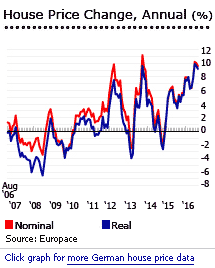 Germany´s housing market price rises have been accelerating for several months. In a country where the housing market has historically been extraordinarily stable, this is a significant shift. The reasons? Strong economic growth, 1.1 million refugees, high work-related immigration, weak construction supply and low interest rates.
Germany´s housing market price rises have been accelerating for several months. In a country where the housing market has historically been extraordinarily stable, this is a significant shift. The reasons? Strong economic growth, 1.1 million refugees, high work-related immigration, weak construction supply and low interest rates.
The German hedonic price index rose by 8% (7.6% inflation-adjusted) during the year to August 2016 (hedonic indices attempt to compare like-for-like exactly, so are the best measure of house price trends). This is up from a 5.8% rise (5.6% inflation-adjusted) during the same period the previous year, based on Europace figures.
Apartment prices rose 9.6% y-o-y (9.2% inflation-adjusted), compared to the 5.4% y-o-y (5.2% inflation-adjusted) growth during the same period last year.
New home prices rose somewhat more than existing homes.
The German housing market was one of the few that avoided a slump in the wake of the 2008-2009 global financial crisis.
German house price changes:
- In 2009, the price index fell by 1.9% y-o-y (-2.7% inflation-adjusted).
- In 2010, prices bounced back, rising by 3.6% y-o-y (2.2% inflation-adjusted).
- In 2011, house prices rose by 4.7% y-o-y (2.7% inflation-adjusted).
- In 2012, house prices rose by 4.6% y-o-y (2.5% inflation-adjusted).
- In 2013, house prices rose by 3.2% y-o-y (1.8% inflation-adjusted).
- In 2014, house prices rose by 3.7% y-o-y (3.5% inflation-adjusted).
- In 2015, house prices rose by 5.6% y-o-y (5.3% inflation-adjusted).
Extremely low interest rates and bond yields have encouraged persistently growing demand, despite the fact that most German mortgage borrowers borrow on long-term interest rates, which are higher than "tracker" rates.
The quantitative easing programme pursued by the European Central Bank, worth about US$65 billion per month, is fuelling fears of housing price bubbles in several eurozone countries – with Germany and Norway most at risk, according to a report by Moody’s Analytics, which also points to high risks in the U.K. (which does not use the euro). The QE programme lowers bank interest rates to zero, encouraging demand for homes. German homes could be overvalued by as much as 10%, warned the Bundesbank in late 2013.
Recently, the migration crisis and strong economic growth have added to the pressure.
Concern about house prices is mounting. The authorities have also considered capping the amount home-buyers can borrow. In March 2016, the German government implemented the Mortgage Credit Directive (MCD), which requires banks to apply stringent rules to borrowers intending to acquire residential properties in Germany. Aside from the property´s value, this new legislation requires banks to examine borrowers´ creditworthiness, making it more difficult for borrowers to obtain mortgage loans.
During the year to Q2 2016:
In North-East Germany:
- In Berlin apartment prices rose by 7.7% to a median price of €3,036 (US$ 3,301) per square metre (sq. m.). The median price of one- and two-family houses rose by 4.6% y-o-y to €2,104 (US$ 2,287) per sq. m.
- Hanover had the strongest y-o-y apartment price hike in Q2 2016, rising by 10.02% to €2,172 (US$ 2,361) per sq. m. However, one- and two-family houses increased by only 1.33% to €1,719 (US$ 1,869) per sq. m.
- In Dresden, median apartment prices rose by 1.79% to €1,987 (US$ 2,160) per sq. m., while one- and two-family houses increased by 6.35% to €1,995 (US$ 2,169) per sq. m.
- In Hamburg, median apartment prices increased by only 1.41% to €3,480 (US$ 3,783) per sq. m. One- and two-family houses rose by 2.57% to €2,325 (US$ 2,528) per sq. m..
In West Germany:
- Dusseldorf had the highest apartment price increase in the region, rising by 7.62% to a median price of €2,261 (US$ 2,458) per sq. m. In contrast, the median price of one- and two-family houses fell by 1.57% to €2,163 (US$ 2,352) per sq. m..
- In Cologne, median apartment prices rose by 5.79% to €2,474 (US$ 2,690) per sq. m. One- and two-family houses had a price increase of 1.92% y-o-y to €2,099 (US$ 2,282) per sq. m.
- In Dortmund, median apartment prise fell by 3.05% to €1,300 (US$ 1,413) per sq. m. Prices of one- and two-family houses also fell by 1.06% to €1,872 (US$ 2,035) per sq. m.
In South Germany:
- Frankfurt had the weakest y-o-y apartment price hike in South Germany, increasing by 3.29% to €2,600 (US$ 2,827) per sq. m. The same is true for its one- and two-family houses, which rose by only 1.44% to €2,219 (US$ 2,413) per sq. m.
- Apartments in Munich enjoy the highest y-o-y price hike in the region, increasing by 10.52% to €4,821 (US$ 5,241) per sq. m. One- and two-family houses had a price increase of 5.75% to €3,627 (US$ 3,943) per sq. m.
- In Stuttgart, apartment prices rose by 9.07% to a median price of €2,519 (US$ 2,739) per sq. m., while the median price of one- and two-family houses rose by 8.29% to €2,525 (US$ 2,745) per sq. m.
All figures from Dr. Klein’s trend indicator of property prices (DTI).
Berlin
Germany’s capital, Berlin, is the seventh most populous urban area in the European Union. The city’s residential sector has been boosted by its young population and growing reputation as a European creative and media hub. It hosts several renowned universities, orchestras, museums, entertainment venues and other creative industries. At the end of 2015, Berlin had a population of around 3.6 million.
Berlin remains as the top leading city for investment prospects in 2016, based on the investor survey by Pricewaterhouse Coopers (PwC) and Urban Land Institute (ULI). Most interviewees believe that the city´s young population, the availability of land for development, as well as the city´s growing technology sector are selling points.
During the first six months of 2016, transaction volume in Berlin was at around €1.1 billion (US$ 1.2 billion), according to Jones Lang LaSalle (JLL). But residential property transactions are in a much smaller scale than last year, with a transaction size averaging at 170 units.
There was a rise in the number of dwelling permits during the first five months of 2016, but 20,000 residential units are needed to meet current requirements, which are unlikely to be met, according to JLL.
Hamburg
Hamburg is “Germany’s Gateway to the World”, and its port is Europe´s third largest. It is Germany´s second largest city, and the eighth largest in the European Union. It is a major tourist destination, and its Speicherstadt was declared a World Heritage Site by UNESCO in July 2015.
Hamburg, takes the second spot after Berlin for investment prospects in 2016, according to the Pricewaterhouse Coopers (PwC) and Urban Land Institute (ULI), The city has flourishing small and medium-sized enterprises, as well as its international trade and business services sectors.
Hamburg´s transaction volume was up by 5% from the city´s five-year average to €320 million (US$ 347.90 million), during the first six months of 2016. According to JLL, investments in the city were present in the "most diverse range of existing properties".
Building permits granted in Hamburg fell to around 8,600 in 2015, down from 10,000 in 2014. Completions, on the other hand, reached a record high of 7,700 new homes. In Spring 2016, the Senate published a new annual housing construction target of 10,000 units, slightly up from the Federal Institute for Research on Building, Urban Affairs and Spatial Development (BBSR) target of over 9,000 new homes.
Munich
Munich is Germany´s third largest city and is home to many major universities, museums, and architectural attractions. It is a traffic hub and is one of Germany´s fastest growing cities. It ranked the highest (4/230) among major German cities in Mercer´s 2016 Quality of Life Index.
Munich has lost its top property ranking to Berlin, which is considerably cheaper. A German developer, respondent of the PwC and ULI survey, said that the city is short of possibilities, stating that "Munich is very restrictive in terms of zoning and where you are allowed to develop".
Nonetheless, Munich remains on many people’s wish-list along with Paris and London. The city’s new target of 8,500 new apartments yearly is still insufficient to meet demand. According to BBSR, the city required 11,200 new apartments in 2015 and should be able to produce 15,000 to 20,000 new homes every year, to meet current demand.
Cologne
Cologne, Germany´s fourth largest city, hosts more than thirty museums and hundreds of galleries, was assessed by local companies to have a weaker economic activity at the end of 2015. However, local companies are much optimistic about 2016, based on the Spring 2016 survey by the Cologne Chamber of Industry and Commerce.
Housing completions in Cologne amounted to almost 4,000 new homes in 2015, the highest since 1999, according to the Office for Urban Development and Statistics Cologne. Around one-third were in Rodenkirchen, whose housing stock increased by more than 7%. in 2015 the increased construction activity helped Cologne to achieve the BSSR´s requirement of 3,900 new homes for the first time. However due to its growing need for houses, the City of Cologne raised its requirement to about 6,000 new homes annually.
Frankfurt
Frankfurt is the fifth largest city in Germany. It is known for its major trade fairs such as Messe Frankfurt, one of the largest in the world; Frankfurt Motor Show, the largest motor show in the world; and Frankfurth Book Fair, also the largest in the world. It ranked 7th out of 230 cities, just behind Düsseldorf (6th) in the 2016 Quality of Living Index published by Mercer.
The city is still the fourth biggest property investment market in Europe, however, investors currently prefer to invest in other German cities. "There has not been a lot of big leasing activity this year and we don’t see new entrants in the tech sector. They like to be in Berlin," according to an investor.
The city’s population – which has climbed to around 724,500 in 2015 - is forecast to reach over 800,000 by 2027. Population growth is focused on the large new-build districts in the city such as Riedberg in the north of the city (peripheral districts) and the Eu ropaviertel (City Centre I). Housing completions reached around 4,100 new homes, a record high for over 20 years, according to the Frankfurt Office for Citizens, Statistics and Elections. However, this is still below the current demand, due to recent population growth.
Stuttgart
Stuttgart is the sixth largest city in Germany and is known as the Cradle of the Automobile. It ranked 24th out of 230 cities in the 2016 Quality of Living Index published by Mercer.
The city has a very good economic sentiment, according to the Chamber of Industry and Commerce. New-build completions were at almost 1,900 homes in 2015, 90% of which were multiple family dwellings, implying land shortages. Despite completions increasing by 11% y-o-y in 2015, residential construction is still inadequate to fulfill the BBSR´s 2015 requirement of around 3,900 residential units.
Publicly owned housing companies and cooperatives, were the city´s biggest net investors, followed by professional asset and fund managers.
Düsseldorf
Düsseldorf, Germany´s seventh largest city has a population of 600,000. It ranked 6th out of 230 cities, just behind Munich (4th), in the 2016 Quality of Living Index published by Mercer.
Housing completions in 2015 fell by over 20% to almost 2,200, after experiencing a substantial rise in 2014, according to the Office for Statistics and Elections of Düsseldorf. According to BBSR, around 1,700 units of new homes are required in Düsseldorf by end of 2016.
There is insufficient construction to satisfy the growing demand
The country´s construction sector is booming. It accounts for 4% of Germany´s GDP and employs 2.5 million people, is expected to increase its nominal sales by 3.5% to €104.7 billion (US$ 113.98 billion) in 2016, according to the German Construction Industry Federation (HDB).
In 2016, around 300,000 new homes are expected to be built, but the expected supply remains insufficient, due to a rising urban population and surge of migrants, according to HDB President Thomas Bauer. He noted that in the medium term, the country needs to build around 400,000 flats annually to prevent housing shortages in cities.
This growth will also be propelled by the government´s initiative to raise its social housing spending and the introduction of tax incentives to for private investors intending to build flats in urban areas.
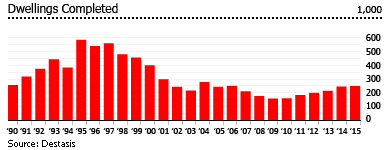
During the first eight months of 2016, dwelling permits issued were 25.1% higher than last year. Dwelling permits rose by 8.4% to 308,687 in 2015, according to the German Federal Statistical Office (Destatis). Dwelling completions, on the other hand, only increased by 1% to around 247,722 units, during the same period. After the mid-1990s there was a substantial drop in housing completions, in part caused by policy changes such as a rise in VAT from 3% to 19% in 2007, and the abolition of owner purchase subsidies.
Market transactions during the first six months of 2016 were around €4.4 billion (US$ 4.78 billion), "one of the weakest half-years" over the last five according to Jones Lang LaSalle. This followed €25 billion (US$ 27.18 billion) transactions in 2015, the country´s highest-ever transaction volume.
The influx of refugees
Germany took in around 1.1 million asylum seekers in 2015. In contrast, in 2016 Germany projects accepting a total of 300,000 refugees, less than a third of last year´s influx, according to the federal office for migrants and refugees (BAMF).
With limited supply of suitable empty flats, the German authorities have turned to public buildings, including former schools and sports centres, as well as a concert hall in Thuringia and a former barracks in Brandenburg, according to Financial Times (FT). But even these are not enough.
Although around 248,000 new apartment units were being under construction in 2015, this number is insufficient to satisfy demand , according to Cologne Institute of Economic Research professor Michael Voigtländer. Aside from tight housing supply, another problem is that refugees tend to locate themselves in big cities, such as Berlin, where the housing supply is even tighter. This makes them compete for housing units with locals and migrants (mainly from other parts of Europe) who are in the country to work.
Some property companies already provided housing to the refugees, including LEG Immobilien, one of the country´s biggest real estate company, which bestowed around 1,830 apartments for refugees. Vonovia, Germany´s biggest housing association, also provided apartments for refugees but chose not to disclose the numbers.
Moderate rental yields in Germany
Many Germans live in rented accommodation. In 2015, 51.9% of Germany´s total households own their homes, according to Eurostat.
Germany´s rental yields are moderate, partly because of recent price rises, but more importantly because investment in housing used to be heavily subsidized by tax-breaks.
Rental yields according to Global Property Guide research in May 2016.
- In Berlin, 90 to 120 square metres (sq. m.) flats have rental yields ranging from 2.99% to 3.54%.
- Rental yields in Frankfurt for 60 to 120 sq. m. apartments range from 3.7% to 3.88%.
- Apartments in Munich have generally lower yields. Yields for 60 to 120 sq. m. flats range from 2.86% to 3.48%.
Rents for existing contracts rose by 79.5% from 1990 to 2015, while rents for new contracts rose by 47.6%. On the average, house prices rose by less over the same period. The average price of owner-occupied houses rose by 64.8%, while the price of terraced houses rose by 53.5%. In 2015, rents across Germany increased by around 3.25%, according to BulwienGesa.
Germany´s conservative mortgage market
The worries of the Bundesbank about banks´ mortghage portfolios seem odd, because despite strong demand, rents have risen faster than prices, and because in mortgage loans in 2015 had fallen to about 40.6% of the country´s GDP - an unusually low level for a developed economy. It was slightly down from last year´s 40.7% of GDP, and a huge plunge from 82% of GDP in 1998. As of April 2016, outstanding home loans amounted to €1,248 billion (US$ 1,370 billion), with €17.9 billion (US$ 19.6 billion) worth of new loans, according to the Deutsche Bundesbank.
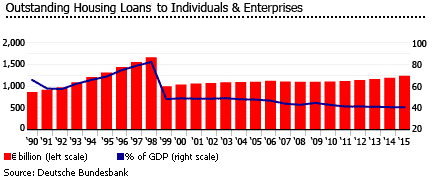
Germans’ conservative borrowing is often attributed to the hyperinflation experienced in the 1920s and has resulted in Germany being less financially volatile than many other developed countries says Deutsche Bank real estate economist Jochen Moebert. However, changes in tax incentives are likely to be a better explanatio of the decline in the mortgage loans to GDP ratio.
Housing loan interest rates are down
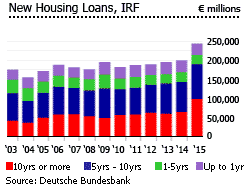
Mostly Germany home-buyers borrow loans at a fixed rate. During the period 2003 to 2015, an average of around 68% of the new loans approved had an initial rate of fixation (IRF) of 5 years or more. Loans with IRF of up to one year have never exceeded 20% of new loans approved.
Loans with interest-rate fixation of up to one year were only 12.4% of total loans approved in 2015, down from the previous year´s 15.8% share of total loans. This interest rate profile gives considerable stability to the German housing market, which tends not to suffer from the sudden lurches in rates, or in the value of houses.
An important explanation for Germany´s interest-rate stability is the loan sources of Germany´s banks, which borrow long, and so are keen to lend long-term.
Housing loan interest rates tend to be stable. Even the dramatic cut in ECB key interest rates, from 4.25% to 1% between September 2008 to May 2009, only caused interest rates on 5-year plus fixed loans to fall from 5.17% to 4.37%.
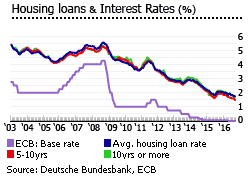
It is only since the ECB implemented its 0.75% base rate in July 2012 that housing loan rates in Germany have been below 3%. Five more rate cuts and the ECB reached the 0% benchmark rate in March 2016. Since then the ECB base rate has been at 0%. Aside from the base rate cut, the ECB also reduced its deposit rate by 10 basis points to -0.40%, and increased its monthly asset purchases to €80 billion (US$ 89.71 billion) from €60 billion (US$ 67.28 billion), since April 2016. These measures were aligned with the bank´s aim in ensuring the continuous economic recovery of the euro zone.
Housing loan rates in August 2016 are as follows:
- Interest Rate Fixation (IRF) up to 1 yr: 2.18%
- IRF 1-5 yrs: 1.77%
- IRF 5-10 yrs: 1.49%
- IRF 10 yrs or more: 1.69%
German economy to expand in 2016
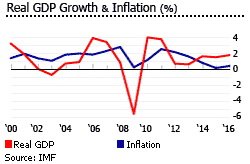
The German economy expanded strongly during the year to Q2 2016, with a 3.1% y-o-y growth, the biggest GDP rise over the last five years, and a strong follow-up from a 1.5% y-o-y growth in the first quarter, according to the Destatis. On a quarterly basis, however, the economy slowed to 0.4% q-o-q in Q2 2016, from a 0.7% growth in Q1 2016. Germany´s economy expanded in 2015, growing by 1.7%, a slight increase from 1.6% GDP growth in 2014, based on the figures from the German Federal Statistical Office (Destatis). While trade has driven economic growth in the recent quarter, the decline of fixed investment, on the other hand, contributed to its slowdown.
The economy is expected to expand by 1.7% in 2016, 1.4% in 2017, and 1.8% in 2018, according to the Deutsche Bundesbank.
"Looking ahead, private consumption should remain an important growth driver on the back of low inflation, low interest rates, low unemployment and higher wages," says ING´s Chief Economist Carsten Brzeski. "In addition, at least in the short run, the refugee crisis will continue to support domestic demand (as already illustrated by strong public consumption numbers over the five quarters) and the construction sector should rebound quickly after the technical correction on the second quarter. The economy’s Achilles’ heel, however, remains the lack of new investment. To kick-start investment in an ageing economy, some government support is needed."
Following the sharp slowdown in 2012, Germany’s economy slowed further in 2013, growing by only 0.6%, according to the IMF. The economy bounced back in 2014 with 1.6% growth and has since then registered robust GDP growth.
Germany’s unemployment rate was 4.2% in August 2016. In contrast, the entire euro area’s unemployment rate was around 10.1%.
In September 2016, Germany´s annual inflation rate was 0.7% according to the Destatis. In June 2016, the Bundesbank slashed its inflation forecast for 2016 from 1.1% to 0.2%. The central bank also expects inflation to rise to 1.5% in 2017 and 1.7% in 2018.
Recently, investors´ confidence in the country plummeted because Germany´s largest bank, Deutsche Bank, faces turmoil that could jeopardize its financial health. In September 2016, the bank´s shares suffered huge declines on news of the US$ 14 billion fine sought by the US Department of Justice, for the bank´s sale of fraudulent mortgage-backed securities before the 2008 financial crisis.
Aside from the multi-billion dollar fine, there was a US$ 7 billion quarterly loss last year, a US$258 million fine for its violation of US sanction laws in November 2015, and a "stress test" failure last June. Investors are questioning the bank´s solvency, and at the end of September 2016 the German government stated that it would not bail out Deutsche Bank.